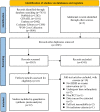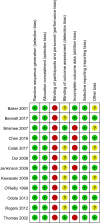Effectiveness of home-based exercise interventions on pain, physical function and quality of life in individuals with knee osteoarthritis: a systematic review and meta-analysis
- PMID: 37461112
- PMCID: PMC10351144
- DOI: 10.1186/s13018-023-04004-z
Effectiveness of home-based exercise interventions on pain, physical function and quality of life in individuals with knee osteoarthritis: a systematic review and meta-analysis
Abstract
Objective: The objective of the study was to evaluate the effectiveness of home-based exercise interventions on pain, physical function and quality of life in individuals with knee osteoarthritis (KOA).
Methods: Five databases (PubMed, Embase, Cochrane Library, CINAHL, Web of Science Core Collection) were searched for relevant randomized controlled trials (RCTs) published from database inception to 2 August 2022. The Cochrane Collaboration's standards were followed for study selection, eligibility criteria, data extraction and statistics, using the Cochrane Collaboration Risk of Bias Tool and PEDro for quality assessment. A meta-analysis and subgroup analyses, stratified by control condition and intervention duration, were conducted using RevMan 5.4. The study was reported in compliance with the PRISMA statement.
Results: A total of 12 independent RCTs with 1442 participants were included. The meta-analysis showed that the home-based exercise interventions significantly reduced pain in individuals with KOA (SMD = - 0.32, 95% CI [- 0.41, - 0.22], p < .01) and improved physical function (SMD = - 0.25, 95% CI [- 0.47, - 0.02], p = .03) and quality of life (SMD = 0.63, 95% CI [0.41, 0.85], p < .001). Subgroup analysis revealed that home-based exercise interventions were superior to health education and no treatment, in terms of pain and physical function, and similar to clinic-based exercise and pharmacologic treatment.
Conclusions: The effect of home-based exercise intervention is significantly better than health education and no treatment for reducing knee pain and improving physical function, and was able to achieve the effects of clinic-based exercise treatment and pharmacologic treatment. With regard to quality of life, the unsupervised home strength exercise intervention showed a significant effect compared with the health education control and combined with cognitive behavioural therapies may produce better results. Although home-based intervention provides effective treatment options for individuals with clinical treatment limitations, individual disease complications and the dosimetry of exercise need to be considered in practice. Furthermore, growing evidence supports the effectiveness of Tai Chi in the rehabilitation of KOA.
Keywords: Home-based exercise; Knee osteoarthritis; Pain; Physical function; Quality of life.
© 2023. The Author(s).
Conflict of interest statement
The authors declare no competing interest.
Figures










References
-
- Vos T, Allen C, Arora M, Barber RM, Bhutta ZA, Brown A, Carter A, Casey DC, Charlson FJ, Chen AZ, Coggeshall M. Global, regional, and national incidence, prevalence, and years lived with disability for 310 diseases and injuries, 1990–2015: a systematic analysis for the Global Burden of Disease Study 2015. The Lancet. 2016;388(10053):1545–1602. doi: 10.1016/S0140-6736(16)31678-6. - DOI - PMC - PubMed
Publication types
MeSH terms
LinkOut - more resources
Full Text Sources
Medical

